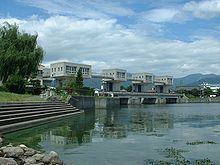Phone number 0266-23-4811 Area 85.1 km² | Website www.city.okaya.lg.jp Population 49,758 (Oct 2016) Local time Thursday 7:36 PM | |
 | ||
Weather 3°C, Wind SW at 11 km/h, 91% Humidity Points of interest Lake Suwa, Toriihira Yamabiko park, Tsurumine Park, Seidenmuseum Okaya, Okayakohan Park | ||
Okaya (岡谷市, Okaya-shi) is a city located in central Nagano Prefecture, in the Chūbu region of Japan. As of 1 October 2016, the city had an estimated population of 49,758 and a population density of 585 persons per km². Its total area was 85.10 square kilometres (32.86 sq mi).
Contents
- Map of Okaya Nagano Prefecture Japan
- Geography
- Surrounding municipalities
- History
- Economy
- Education
- Railway
- Highway
- International relations
- Local attractions
- Noted people from Okaya
- References
Map of Okaya, Nagano Prefecture, Japan
Geography
Okaya is located in central Nagano Prefecture at the outlet of Lake Suwa and the headwaters of the Tenryū River.
Surrounding municipalities
History
The area of present-day Okaya was part of ancient Shinano Province. The village of Hirano was created with the establishment of the municipalities system on April 1, 1889. Hirano was raised to directly city status on April 1, 1936, and is one of the eleven villages in Japan which have skipped the intermediate town stage to directly become a city. Okay annexed neighbouring Shijiri town and Chikumaji village on January 1, 1951, followed by Minato village on January 1, 1955, Kawagishi village on February 1, 1955 and Osachi village on March 25, 1957.
Economy
The region's local industry is predominantly made up of medium and small-size businesses, but some larger corporations, including Seiko Epson, Olympus and Kyocera have factories in Okata.
From the Meiji period through the early Shōwa period (1868-1930), the Okaya area was one of Japan's largest producers of export-quality silk, due to the introduction of a new silk-reeling machine from overseas.
After the World War II, Okaya established itself as a manufacturing city of precision machinery, focusing on producing products such as watches and cameras.
Education
Okaya has seven public elementary schools and four public middle schools. The city has three public high schools operated by the Nagano Prefectural Board of Education.
